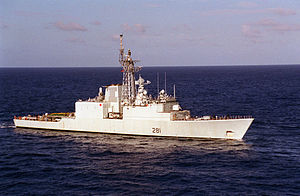
Iroquois-class destroyers, also known as Tribal class or DDG 280 class, were a class of four helicopter-carrying, guided missile destroyers of the Royal Canadian Navy. The ships were named to honour the First Nations of Canada.
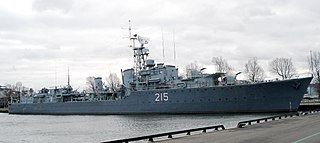
HMCS Haida is a Tribal-class destroyer that served in the Royal Canadian Navy (RCN) from 1943 to 1963, participating in World War II and the Korean War. She was named after the Haida people.
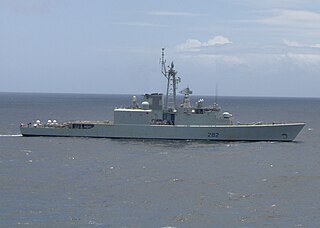
HMCS Athabaskan was an Iroquois-class destroyer that served in the Royal Canadian Navy from 1972 until 2017. Athabaskan was the third ship of her class which is sometimes referred to as the Tribal class or simply as the 280 class. She is the third vessel to use the designation HMCS Athabaskan.

HMCS Algonquin was a V-class destroyer, laid down for the Royal Navy as HMS Valentine (R17) and transferred to the Royal Canadian Navy on completion during the Second World War. She saw service in the Second World War escorting the aircraft carriers that bombed the Tirpitz in March 1944 and providing naval gunfire support to the Normandy landings. The destroyer was to participate in the Pacific Campaign but the war ended before her arrival in that theatre. Algonquin was converted in 1953 to a frigate and spent the majority of her remaining career in the Atlantic, being paid off in 1970.

HMCS Regina is a Halifax-class frigate that has served in the Canadian Forces and Royal Canadian Navy since 1993. Regina is the fifth vessel in her class which is the name for the Canadian Patrol Frigate Project. She is the second vessel to carry the designation HMCS Regina. She is assigned to Maritime Forces Pacific (MARPAC) and is homeported at CFB Esquimalt.

HMCS Algonquin was an Iroquois-class destroyer that served in the Royal Canadian Navy (RCN) from 1973 to 2015.

HMCS Iroquois was the lead ship of the Iroquois-class destroyers of the Royal Canadian Navy, also known as the Tribal class or the 280 class. The second vessel to carry the name, she carried the hull number DDG 280. Entering service in 1972 she was assigned to Maritime Forces Atlantic (MARLANT) and was homeported at CFB Halifax. Iroquois was deployed overseas for blockade and anti-terrorism duties, including participating in Operation Apollo in 2002–03. Taken out of service in 2014 and paid off in 2015.

HMCS Alberni was a Flower-class corvette that served in the Royal Canadian Navy (RCN) during the Second World War. The Flower-class corvettes were warships designed for anti-submarine warfare. The ship was constructed by Yarrows Ltd. in Esquimalt, British Columbia, laid down on 19 April 1940, launched on 22 August and commissioned on 4 February 1941. The corvette sailed east to join the RCN's fleet in the Atlantic via the Panama Canal, where upon arrival, the vessel began escorting trans-atlantic convoys in the Battle of the Atlantic. Alberni took part in the key convoy battle of Convoy SC 42. In 1942, the corvette was transferred to Allied convoy assignments associated with Operation Torch in the Mediterranean Sea. In 1944, Alberni was among the Canadian naval vessels assigned to Operation Neptune, the naval component of the invasion of Normandy and escorted support ships to and from the United Kingdom on D-day.

HMCS Sioux was a V-class destroyer of the Royal Canadian Navy which fought in the Second World War and the Korean War. She was launched as HMS Vixen for the British Royal Navy before being transferred to the Royal Canadian Navy. She was then named for the Sioux people of Canada's western provinces.
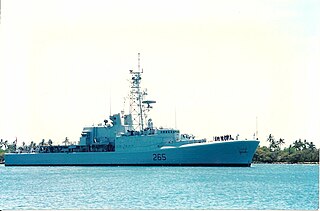
HMCS Annapolis was an Annapolis-class destroyer that served in the Royal Canadian Navy and later, the Canadian Forces. She was the second Canadian naval unit to carry this name. Named for the Annapolis River that flows through Nova Scotia, the ship entered service in 1964, the last of the St. Laurent-class design. Serving through the Cold War, Annapolis was decommissioned in 1998 before going through a protracted legal battle for use as an artificial reef. She was finally scuttled as such in 2015 off the coast of British Columbia.

HMCS Crescent was a C-class destroyer that was built for the Royal Navy but was transferred before completion and saw active service with the Royal Canadian Navy. She was one of 32 destroyers of that class built between 1943 and 1945 as part of the War Emergency Programme.
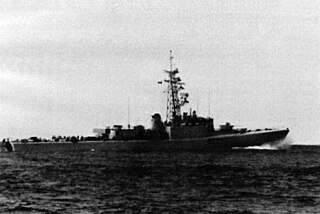
HMCS Restigouche was the lead ship of the Restigouche-class destroyers that served in the Royal Canadian Navy and later the Canadian Forces. Commissioned in 1958, Restigouche remained in service until 1994. She was sold for use as an artificial reef, however controversy arose over her acquisition and instead she was scuttled off the coast of Mexico in 2001. She was the second Canadian warship to carry the name HMCS Restigouche.

In the Canadian Armed Forces, Maritime Forces Pacific is responsible for the fleet training and operational readiness of the Royal Canadian Navy in the Pacific Ocean. It was once referred to as Canadian Pacific Station.

HMCS Saguenay was a St. Laurent-class destroyer that served in the Royal Canadian Navy and later the Canadian Forces from 1956–1990. She was the second vessel in her class and the second Canadian naval unit to carry the name HMCS Saguenay. After being discarded by the Canadian Forces, the ship was sunk as an artificial reef off the coast of Nova Scotia.
HMCS Ottawa was a St. Laurent-class destroyer that served in the Royal Canadian Navy and later the Canadian Forces from 1956 to 1992. Ottawa was the first bilingual ship to serve in the Canadian navy.
The Royal Canadian Navy uses hull classification symbols to identify the types of its ships, which are similar to the United States Navy's hull classification symbol system. The Royal Navy and some European and Commonwealth navies use a somewhat analogous system of pennant numbers.

HMCS Esquimalt was a Bangor-class minesweeper that served in the Royal Canadian Navy during the Second World War. She saw service in the Battle of the Atlantic and in the Battle of the St. Lawrence. She was sunk in 1945, the last Canadian warship to suffer that fate. She was named for Esquimalt, British Columbia.
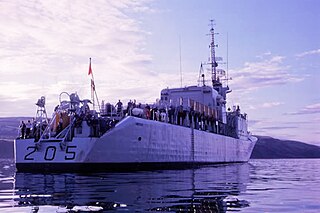
HMCS St. Laurent was a St. Laurent-class destroyer that served in the Royal Canadian Navy and later the Canadian Forces from 1955–1974. She was the lead ship of her class, the first modern warship designed and built in Canada.

HMCS Margaree was a St. Laurent-class destroyer that served in the Royal Canadian Navy and later the Canadian Forces from 1957–1992. She underwent conversion to a destroyer helicopter escort (DDH) in the mid-1960s and was officially reclassed with pennant DDH 230 on 15 October 1965. The vessel served until 1992 when it was discarded, sold for scrap and broken up in 1994.

HMS Comet was a C-class destroyer built for the Royal Navy in the early 1930s. She saw service in the Home and Mediterranean Fleets and the ship spent six months during the Spanish Civil War in late 1936 in Spanish waters, enforcing the arms blockade imposed by Britain and France on both sides of the conflict. Comet transferred to the Royal Canadian Navy (RCN) in 1938 and renamed HMCS Restigouche. During World War II, she served as a convoy escort in the battle of the Atlantic, on anti-submarine patrols during the invasion of Normandy, and was employed as a troop transport after VE Day for returning Canadian servicemen, before being decommissioned in late 1945. Restigouche was sold for scrap in 1946.
